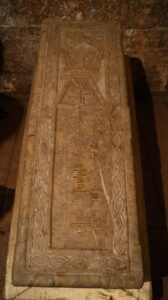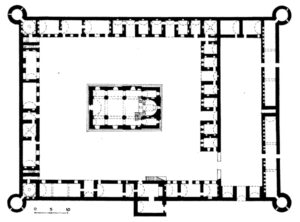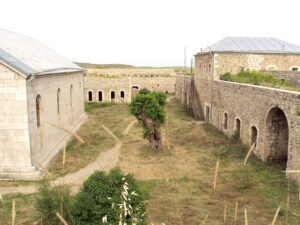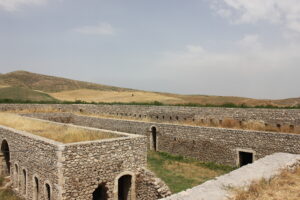Amaras Monastery
Martuni Province, Sos village
Amaras Monastery is located in the province of Haband in historic Artsakh, 10 km. south of the moder-day regional capital of Martuni, in the ravine between the Khazagh and Lusavorich mountains.
The Monastery was founded in the 4th century by St. Gregory the Illuminator and completed by his grandson, Grigoris, the first bishop of Artsakh. During the 4th century the monastery was destroyed by the Persians. At the end of the 5th century it was rebuilt by King Vachagan III the Pious, erecting a memorial chapel over St. Grigoris' grave.
The Monastery was the regional episcopal see and a major center of culture, education and commerce. In the 5th century St. Mesrop Mashtots opened the first Armenian school in Artsakh at Amaras. Throughout history, Amaras Monastery was attacked repeatedly by invaders. The monastery had such sturdy walls that during times of peril, the local population often took refuge in this citadel. In 640, during their invasion of Artsakh, the Arabs plundered and destroyed the monastery, which was rebuilt by Prince Yesayi of Dizak in the 9th century.
The monastery suffered great destruction at the hands of the Turks, Seljuks, Tatars and Mongols, particularly during the invasions of the Mongol Khan Abasha and the Turkoman Tamarlane. In 1293 the Tatar Batu Khan plundered St. Grigoris' staff and a gold cross, which was set with 36 gems, one for each letter of the Armenian alphabet. Later, Artsakh craftsmen created 36 new gems with Armenian letters and inlaid them on 36 stations around Amaras.
When Tamarlane's troops overran Amaras in 1387, he ordered his soldiers to form a line from the monastery to the Arax River and dismantled the monastery stone by stone, the soldiers handing the stones down the line and throwing them into the river. As Armenians have traditionally done, after the marauders left, the people collected all of the stones and rebuild the monastery. Once again the Armenian language and Divine Liturgy were restored at this ancient spiritual center. Throughout these bitter challenges, Amaras Monastery did not lose its episcopal see status, and overcame the most difficult of circumstances to remain a center of vibrant monastic life.
The monastery continuously operated a school and scriptorium where illuminated manuscripts were copied, which survive to this day, flourishing particularly in the 16th century. In 1664 the monastery built a summer residence and church in honor of St. Grigoris in Herher village. The Turks and Persians invaded in the 17th century, causing new damage to Amaras.
For nearly 14 centuries, Armenian prayers were heard at Amaras Monastery, silenced only from 1928 to 1988, when Artsakh came under the Azeri yoke.
For nearly 14 centuries, Armenian prayers were heard at Amaras Monastery, silenced only from 1928 to 1988, when Artsakh came under the Azeri yoke. Since 1988, the national liberation movement breathed new life into this ancient monastery, and on September 7, 1990 the monastery's bells began to ring again. Although the monastery was briefly captured by the Azerbaijanis in 1992, shortly thereafter the Nagorno-Karabagh Army finally liberated the monastery.
The effort to restore the monastic complex and monastic life continues to this day.
As one of Armenia's most significant holy places, the restoration of Amaras was a highlight of the 1700th-anniversary celebration of Armenia's adoption of Christian as a state religion in 2001.
- SONY DSC
- SONY DSC
Bibliography
«Diocese of Artsakh» (2009), Erevan, 411 pp.

















